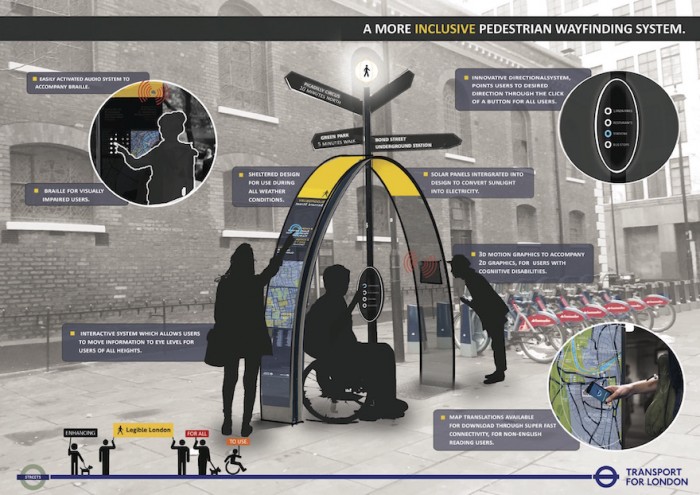Deborah Abidakun, an interior design student from De Montfort University, has created A More Inclusive Pedestrian Wayfinding System: a wayfinding system building on the existing “Legible London” system that creates an enhanced and more user-friendly pedestrian navigation system for all users, including those with disabilities. Her design won an RSA Student Design Award 2016 in the Inclusive Cities category, which called for ideas that made spaces more accessible for all users. We interviewed Abidakun about her thoughtful design.
What inspired your wayfinding system and how did you develop the idea?
The Inclusive Cities brief was to design an inclusive building, space or place that could be easily accessed and used by everyone.
After carry out initial research into inclusive design, the key principles and existing examples, I came upon the quote "Disabled by Design". This refers to the idea, that disability arises not within an individual, due to their capability, but as a result of the built environment, products and services that fail to take into account the needs of all potential users. It was on this basis, that the Legible London Pedestrian way finding system came into perspective.
I have had several personal experiences with the existing pedestrian way finding system, in five out of 10 of those experiences I felt the design was not optimized to suit everyone’s needs. In my case, for example, I found the combination of radial diagrams, with 3d graphics on the maps quite confusing, I am just below the average height so reading some of the street signs I found myself tiptoeing to comfortably access and read the information, at night when reading the text printed on the signage I found myself straining my eyes because of the lack of lighting. All these cases left me questioning how other users, who actually had a disability felt using the existing prototype? This led me to carry out further research around the existing pedestrian way finding system, which revealed some underlying flaws.
Was it designed specifically for London?
My proposed prototype is designed for London, but through further research and development it can be adapted to fit different locations across the United Kingdom.
How did you research the project? What kinds of questions did you ask to find out what you needed to include in the design?
I found that although the existing Pedestrian Way Finding system was an impeccable move towards inclusivity, it still did not fully embody the philosophy. During the initial stages of my two week project I carried out primary investigation and market research; this involved me observing how users interacted with one of the existing prototype in one of the busiest locations in London: Oxford street. At this stage I did recognize that the pedestrian way finding system was being used but not by everyone, I identified five main users excluded from the design: foreign demographic (non English speaking or reading), users with visual impairments (registered blind, or elderly users), users with "hidden" disabilities (cognitive disabilities), and in some cases users with physical impairments (wheelchair users, dwarfism).
Have you kept some of the aesthetic design of the current system in your new one?
I played on the existing design of Legible London; the reason behind this is that one of the main points from my proposal was the fact that if the project was to be taken further it would cost effective. It is an enhancement of the existing pedestrian way-finding system implemented by Transport for London. I have combined new features with the existing design, this is because the existing materials have proven to stand the test of time and are both durable and robust. Overall this means both my proposal and the existing prototype share similar aesthetics however, the new features, selected through market and further research will mean the new prototype will target a wider range of users than previously achieved.
What does winning an RSA Student Design Award mean to you?
Being selected as a winner of the RSA Student Design Awards has given me confidence in myself as a young designer. For my project to be recognized by a range of professionals from different backgrounds is a huge achievement for me!
I hope to expand my knowledge in inclusive design and integrate this with my passion for interior architecture and design.
Do you intend to take this project further? How can you do that?
I would like to take the project further, and maybe one-day pitch the idea to Transport for London. I believe with further research and development with their guidance and facilities the prototype could be tested with different focus groups and possibly implemented.
Can you tell me a little bit about yourself and your background?
I am 21 years old, I was born in London and lived here all my life however my parents are from Africa – Nigeria. I will be graduating from De Montfort University with a Bachelors degree in Interior Design in July.
What do you think the role of the designer is today?
I believe it is the role of designers today to design to evoke emotional response or change and create awareness. This can be summarised as “design with purpose”.
What are your biggest learnings from studying design - what (methodologies or philosophies) do you hope to take with you into your work?
One of the biggest learnings from studying design, is that “design is not just what it looks like and feels like. Design is how it works” this was a quote made by (Steve jobs). I plan to apply this throughout my career.









